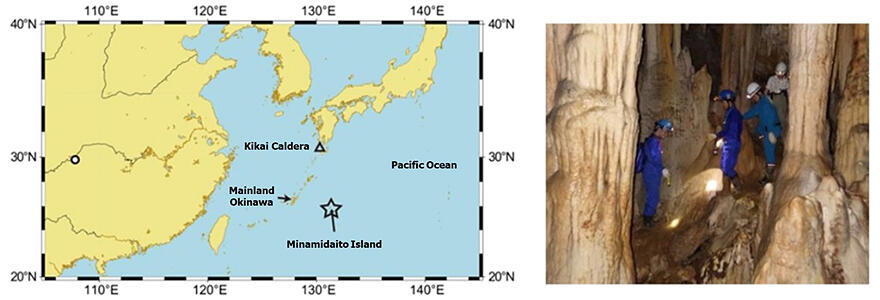A series of major volcanic eruptive events that had occurred about 7,000 years ago was followed by decades of cold weather. This phenomenon was discovered by a research group including Associate Professor Ryu Uemura and Researcher Syed Azharuddin of the Graduate School of Environmental Studies at Nagoya University, through collaborative research with Associate Professor Ryuji Asami of the Graduate School of Science at Tohoku University, and National Taiwan University, after analyzing stalagmites in Okinawa. The results have been published in Communications Earth & Environment.

Provided by Nagoya University
Climate is known not only to fluctuate annually but also to exhibit cyclic variations on a multidecadal scale. The Atlantic Multidecadal Oscillation (AMO) is a prime example for this. It remains unclear whether this variation is due to internal ocean movements or external factors, such as large-scale volcanic eruptions.
The research group used stalagmites collected from caves on the Minamidaito Island, Okinawa Prefecture, as samples. Stalagmites preserve trace amounts of water originating from precipitation occurred in the past as fluid inclusions.
Using a unique and highly sensitive analytical method, the researchers measured the stable isotope ratios of oxygen and hydrogen in this trace amount of water, and they further analyzed the oxygen isotopes in stalagmites to estimate past temperatures. Radioisotope dating (uranium-thorium dating) of the stalagmite sample indicated that it grew approximately 7,300-6,400 years ago.
Compared to volcanic eruption data inferred from Arctic and Antarctic ice cores, eruptions were particularly common during this period, with the occurrence of multiple large eruptions. In particular, an eruption that has happened about 7,180 years ago is considered the largest in the past 10,000 years, seven times as large as the Tambora eruption, one of the largest in modern times. Furthermore, the giant eruption of the Kikai Caldera occurred roughly at this time and was likely to correspond to the volcanic signal of the ice core.
There were four eruption clusters during this period, including a giant eruption followed by multiple large eruptions. Analysis of stalagmites in this study based on the average of multiple volcanic eruption indicated that a cooling by approximately 2℃ occurred over the 40 years or so after each eruption, followed by a recovery of the climate 70-90 years later.
Temperature fluctuations inferred from stalagmites were consistent with the Greenland ice core temperature record, indicating that a climatic link (teleconnection) might have existed between the North Atlantic and West Pacific.
The direct impact of aerosols generated from volcanic eruptions on the climate lasts for few years. However, decade-long variations revealed in this study could not be explained by a simple short-term aerosol impact.
It was suggested that a series of large volcanic eruptions might have occurred such that a cool trend was experienced, which in turn might have affected the climate and sustained cooling for several decades.
This study provides important clues for understanding the mechanisms of the multidecadal climate change that continues to be debated in the perspective of current weather phenomena and quantitatively understanding the relationship between volcanic activity and climate change.
Journal Information
Publication: Communications Earth & Environment
Title: Multidecadal hydroclimate responses to volcanic forcing in the Mid-Holocene
DOI: 10.1038/s43247-025-02047-0
This article has been translated by JST with permission from The Science News Ltd. (https://sci-news.co.jp/). Unauthorized reproduction of the article and photographs is prohibited.




